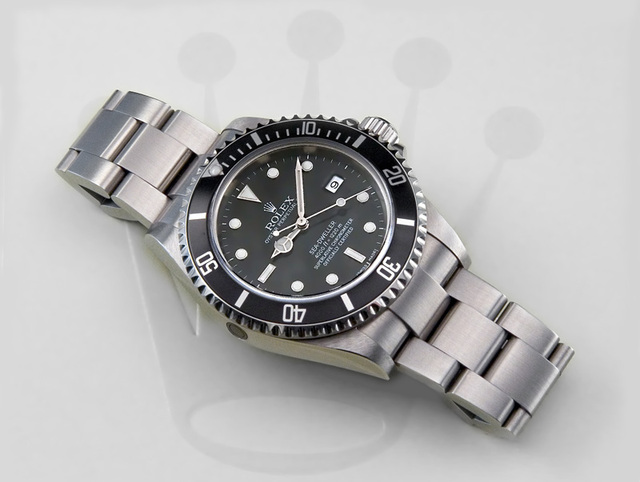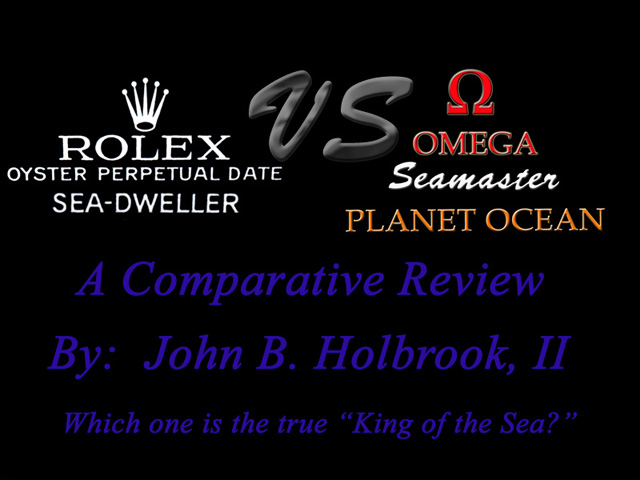
Comparative Review of the Rolex Sea-Dweller
VS. Omega Planet Ocean
By: John B. Holbrook, II
February 3rd, 2007
As I sit down to write this comparative review, I realize it's been 4 years since I compared dive watches from Rolex and Omega. In the four years since I first compared the Omega Seamaster Professional to the Rolex Submariner and the article has become one of the most popular watch related articles on the web - hardly a week goes by that someone doesn't read the article and write to me with questions or comments. As much as I'd like to take credit for the popularity of the article, it's the topic which is very interesting. In the world of luxury watches, the rivalry between Rolex and Omega is every bit as strong as that between Ford and Chevy in the car world, or the University of Michigan and Ohio State University in the world of college football. And the fans of each brand are both loyal and legion.
In the years since my previous comparison, Omega has created a new dive watch - the Seamaster Planet Ocean. Inside and out, the Planet Ocean is watch with specifications which exceed those of the previous generation Seamaster Professional. While the Seamaster Professional is a watch that compares well with the Rolex Submariner, the Planet Ocean is more appropriately compared to Rolex's true deep-sea diving tool watch - the Sea-Dweller.
Firstly, a word about the methods by which I'm using to evaluate these two watches, and my own personal biases. Firstly, I'm not weighting the categories in any way. Each category (bracelet, clasp, case, price, etc.) are an equal component of the final overall score. For some people, price, for example, is much more an important of a category than, say the clasp. Feel free to weight each of these categories with your own values to arrive at your own conclusions. Secondly, let me disclose that the Seamaster Planet Ocean used in this article is not my own - it belongs to fellow WATCH TALK FORUMS Rolex Forum Administrator Scott D. If you get the opportunity, stop by WATCH TALK FORUMS at www.watchtalkforums.info and thank Scott loaning his watch to me for the purposes of writing this review. Now, on to the shootout!

As you can see from the above photograph, there's a substantial size difference between the Sea-Dweller and the Planet Ocean. At 45.5mm in diameter, the Planet Ocean seemingly dwarfs the 40mm diameter Sea-Dweller. Accordingly, the Planet Ocean weighs considerably more than the Sea-Dweller - this is easily one of the heaviest watches, if not the heaviest watch, I've ever tried on. It feels at least 30% heavier than the Sea-Dweller. Is being bigger and heavier a good thing? That's purely a matter of personal preference. From my stand point, 40mm is a pretty nice size - I can wear the 42mm Seamaster Professional, but the 45.5mm Planet Ocean was just too big and heavy for my taste. Fortunately, the Planet Ocean does come in a 42mm version, so if you're considering the Planet Ocean, make sure you try on both sizes before buying one.
CASE
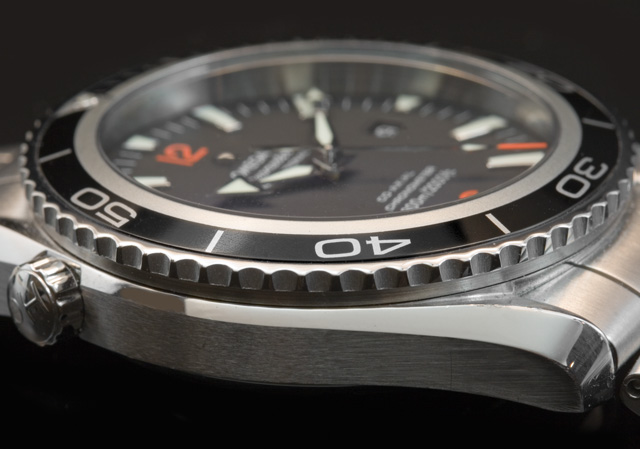
Planet Ocean: The PO case caries over some legacy design features of previous Seamaster generations, which is a good thing. It blends both polished and brushed finished surfaces for both cosmetic appeal, and functional advantage. The case is rated for 600m/2000ft. water resistance, which makes it twice as water resistant as the previous Seamaster Professional. A helium release valve is built into the case, making this watch particularly useful in extended time deep dives. The case has numerous angles and curves which vary the way light strikes and is reflected from the case, yet, there are no sharp corners and it's completely comfortable. Of course, there's the gorgeous Sea Monster logo on the case back. RATING: 9

Sea-Dweller: The Oyster case is a simple, yet classic design which has been often copied. The Sea-Dweller is rated for an astounding 1220m/4000 ft. of water resistance Like the bracelet (see my conclusion below on the use of 904 vs. 316L grade steel) the case is constructed from 904 grade steel. The case is also equipped with a helium escape valve, which is integrated in the case, and deploys if critical pressure thresholds are exceeded. RATING: 10
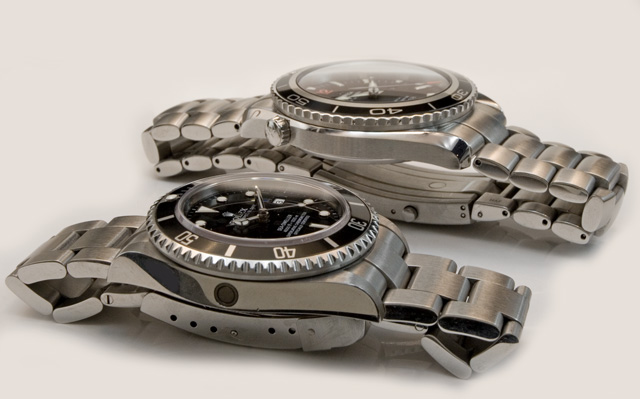
Winner: Sea-Dweller. The Oyster style case was the birth of the diving watch, but let us not forget that Omega was a pioneer in creating a water resistant (or water proof as was designated at the time) watches. The Sea-Dweller gets the nod here, based on being twice as water resistant as the Planet Ocean, and because of the more advanced design of the integrated helium escape valve.
BEZEL
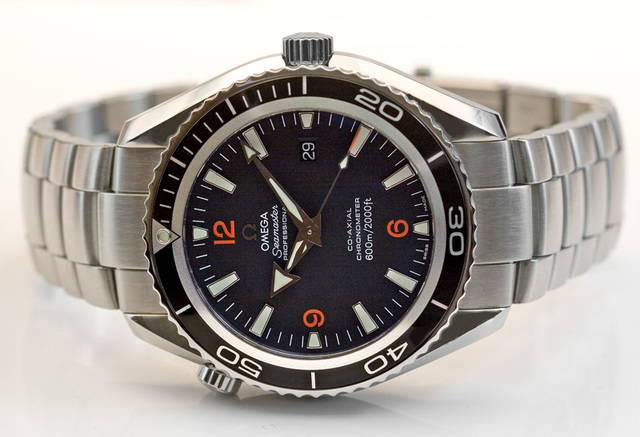
Seamaster: The PO unidirectional bezel is much improved over the Seamaster Professional bezel, as the PO's new coin edge design is more easily gripped underwater than the scalloped bezel of the SMP. I can easily grip it, and it has nice "click" sound as it makes its way around the dial. The markings on the bezel align perfectly with both the dial markers and hands, and are very legible. I find no flaws here. RATING: 9.5
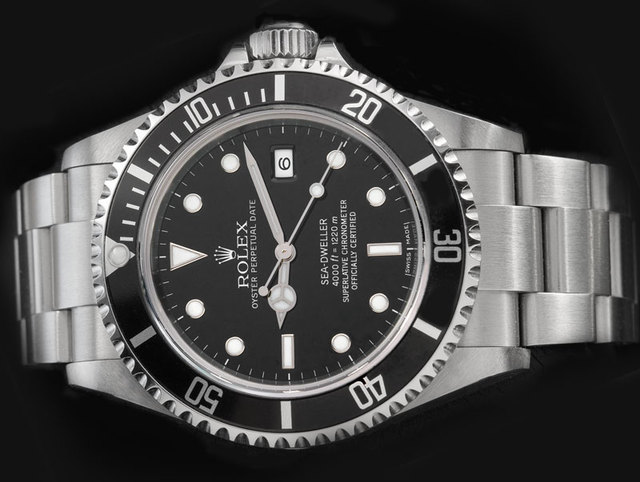
Sea-Dweller: The unidirectional bezel is about the most easily turned which I've ever tried - extremely smooth and precise. I can easily grip it, and it has nice "click" sound as it makes its way around the dial. The markings on the bezel align perfectly with both the dial markers and hands, and are very legible. I find no flaws here. RATING: 10
DIAL, MARKERS, & HANDS
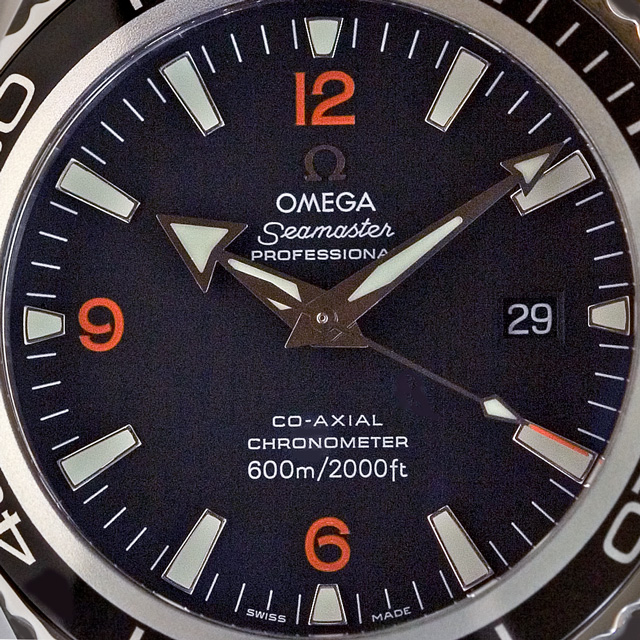
Seamaster: The oversized markers and the large arrowhead hands make for excellent visibility. The luminescent coating (Superluminova) on the hands and markers makes glow very strong, but I believe the previous Seamaster Pro hands and markets are just a bit stronger due to the available surface area . The date, while unmagnified is also easily read. RATING: 10
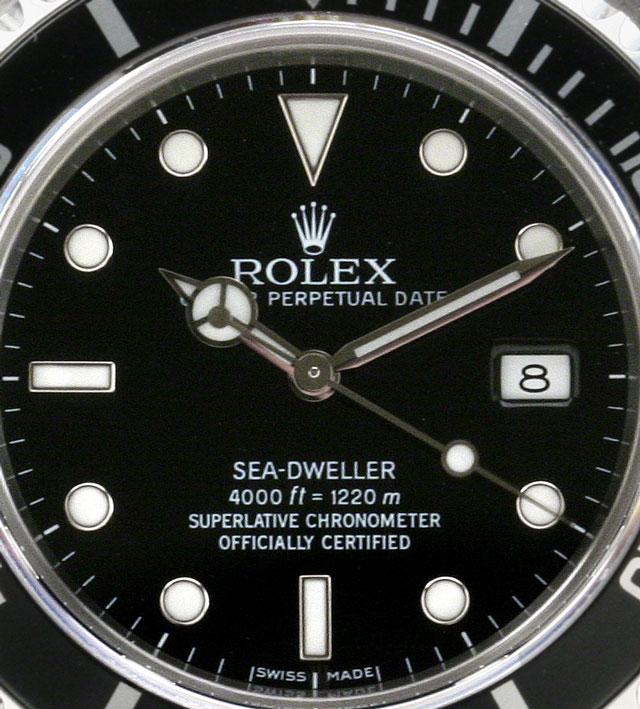
Sea-Dweller: The dial of the Sea-Dweller is a work of art, and perhaps one of the most copied styles in watch history. The white gold markers and Mercedes style hands are a classic. Unlike the Submariner, the Sea-Dweller does not have a magnification bubble over the date, giving the dial area a cleaner look. Rolex also uses Superluminova on the hands and markers, but they have a smaller surface area compared to the Planet Ocean, so the glow isn't as bright. RATING: 9
WINNER: Seamaster. Both dials are excellent, but the Planet Ocean will clearly be the more legible of the two both above and below the water by virtue of its size alone.
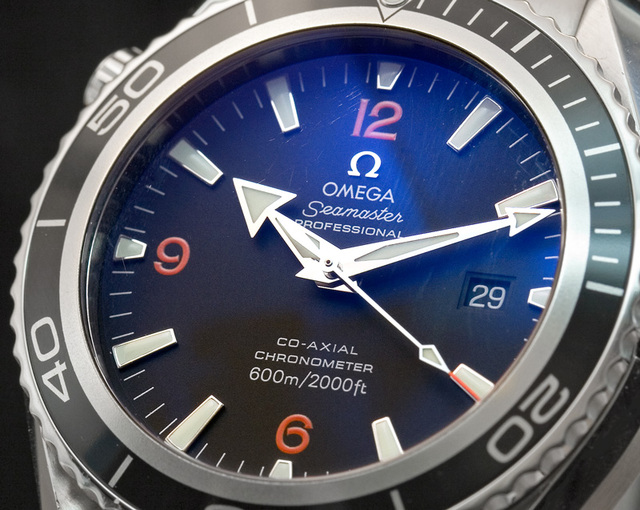
Seamaster: The Planet Ocean uses a Sapphire crystal that has an anti-reflective coating applied to both sides (top and bottom). Applying a coating to the topside of a sapphire crystal is a horrible mistake, and you can see why in the above photo. While the crystal is scratch resistant due to the man-made sapphire from which it is cut, the coating applied to the crystal can be scratched and will eventually show up, as you can see is happening to Scott's PO. Additionally, the dual coating gives the dial a distinct and (in my opinion) unattractive blue hue from certain lighting angles, which you can also see in the above photos. Both of these problems are avoided when the AR coating is simply applied to the underside of the crystal, where it can't be scratched - Omega did this with the Seamaster Professional, so its a mystery to me as to why they changed direction with the Planet Ocean. To me, this is a serious flaw. RATING: 7
Sea-Dweller: A sapphire crystal is also used on the Sea-Dweller, but no anti-reflective coating is applied. The crystal is also quick thick, and stands up well above the bezel - the increased thickness is necessary for its depth rating, and does not impact dial visibility. RATING: 8.5
WINNER: Sea-Dweller - I 'd love to see what a Rolex dial would look like with an AR coating applied to the underside of the crystal, but the lack of it on the Sea-Dweller doesn't create any serious visibility problems. The double AR coated PO crystal is a serious problem however - were I to own one, I'd have to go to the expense of having the top site coating removed.
BRACELET
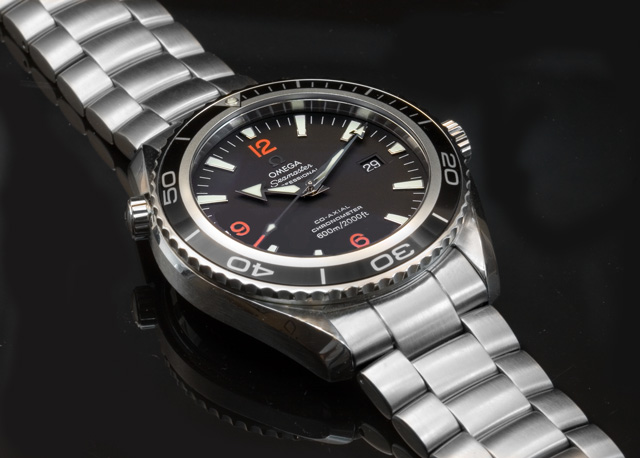
Seamaster: This is an extremely thick and heavy bracelet - it does not taper as the bracelet gets closer to the clasp like most other bracelets. Solid end links and center links are used, and this bracelet isn't a hair puller. The bracelet top and bottom have a brushed finish, and the sides are polished. It's well constructed, but the weight of it won't appeal to everyone. Friction pins are used in the adjustable links. RATING: 9
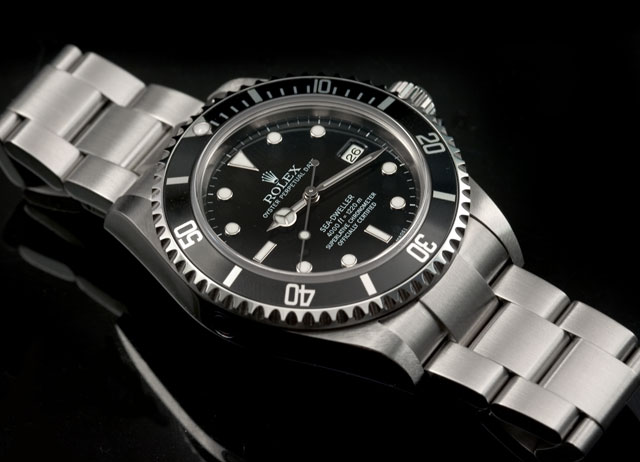
WINNER: Seamaster. Tough call here - each has obvious strengths and weaknesses. The PO bracelet feels like a much heavier, more substantial bracelet. The Sea-Dweller bracelet is, to me, more comfortable. Rolex uses a higher grade steel (904) than Omega (316L) in the bracelet. However, I can discern no significant functional advantage for them to do so in a watch bracelet, and 904 grade steel is approximate 3 times more expensive than 316L. My research indicates 904 grade steel is more commonly used in industrial components which under constant exposure to highly corrosive substances (acids and the like) - conditions which a watch bracelet simply will not be exposed to. Therefore, there is no appreciable benefit to the 904 grade steel in the Rolex bracelet as compared to 316L used in the Omega bracelet. Indeed, no other watch manufacturer uses 904. The Oyster bracelet on the SD will be easier to size, by virtue of the screws in the adjustable links as opposed to friction pins in the PO bracelet: Slight edge to the PO for solid center links.
CLASP
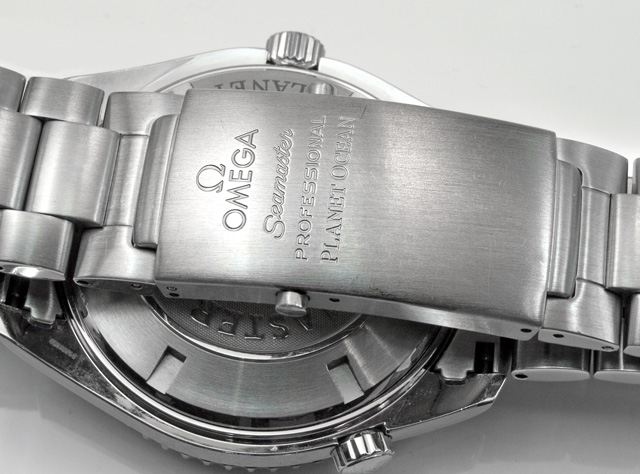
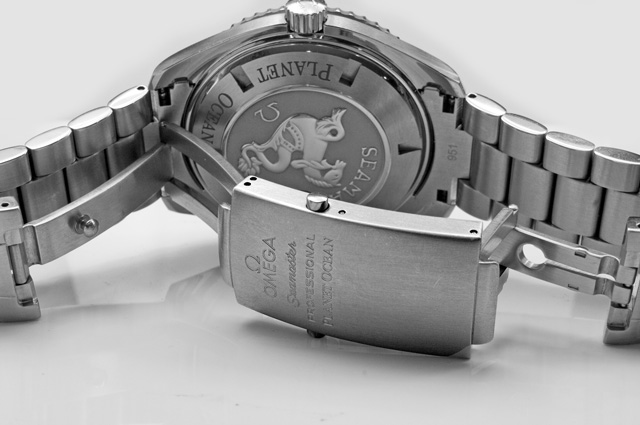
Seamaster: The Planet Ocean uses the same two-button deployment clasp with integrated diver suit extension used on the Seamaster Professional. The clasp is easily opened and closed, yet feels extremely sturdy. The diver extension is also easily deployed. The clasp has an extremely high quality feel, and is the best bracelet clasp I have ever used. The large amount of smooth surface area on the bottom of the clasp is reputedly scratch- prone, but I've found the scratches are easily buffed out. The clasp also lacks a fine adjustment pin (the bracelet includes a half-sized link for sizing purposes) which some feel detracts from the comfort of the overall bracelet. RATING: 8.5
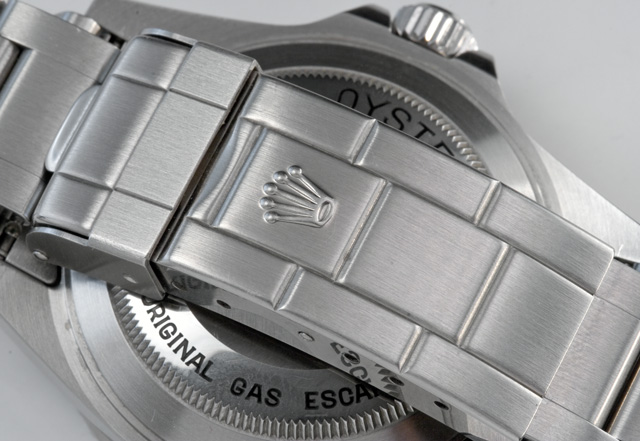
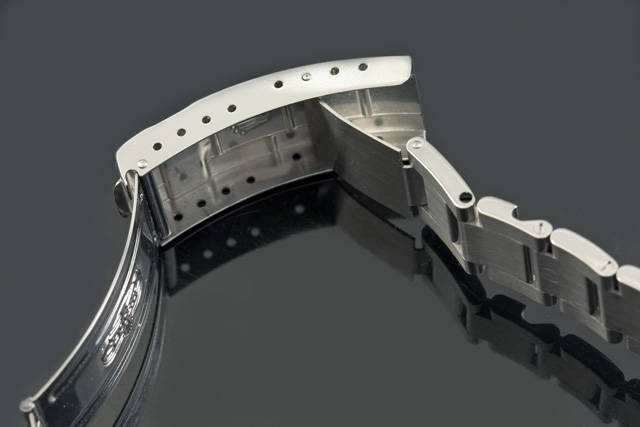
Sea-Dweller: The clasp is easily the weakest point on the entire watch. The flip lock clap has been used on Rolex watches for years, and functionally is quite secure, and extremely scratch resistant. However, the flimsy, thin, stamped sheet metal used in the clasp is simply unacceptable given the price of the watch. Many users report the divers extension is difficult to use. Yes, the clasp does the simple job it was designed to do. No, Rolex has absolutely no motivation to do anything differently based on the sales success. RATING: 7.5
WINNER: Seamaster. The Omega clasp is superior in both form and function.
MOVEMENT
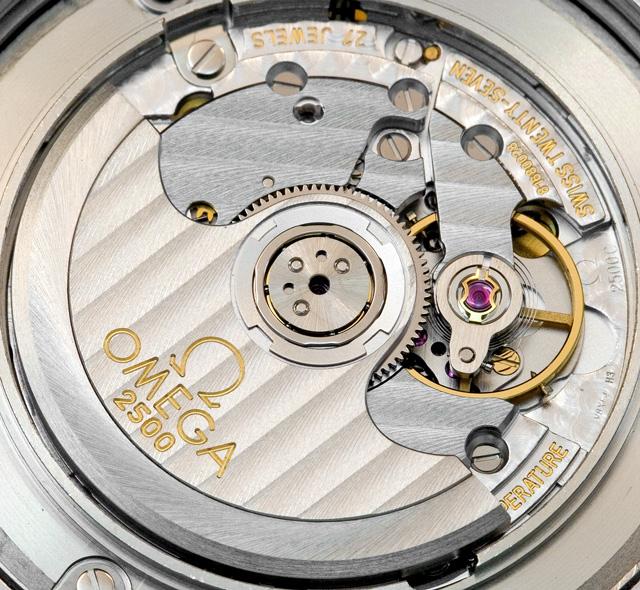
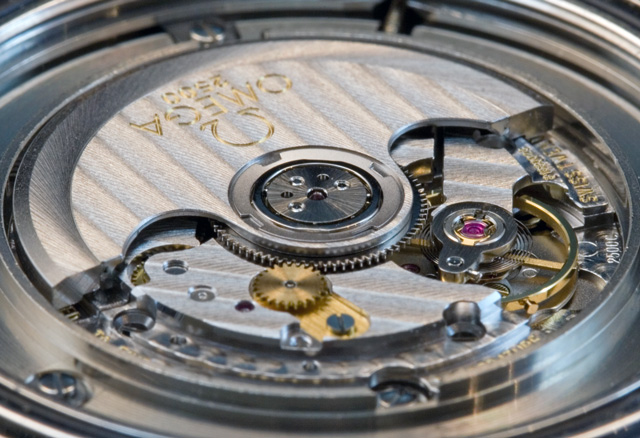
Seamaster: the self-winding Caliber 2500 is based upon the ETA 2892-2. The use of the ETA ebauche means that the Caliber 2500 isn't considered an "in house" movement, or manufacturer's caliber in the strictest of sense. But, given that both Omega and legendary movement manufacturer ETA are owned by the Swatch Group, the Caliber 2500 might just be an "in family" movement even if it isn't manufactured completely "in house" by Omega. The Caliber 2500 ads 2 more jewels as compared to the Caliber 1120 (27 jewels in total) as well as employing the revolutionary Co-Axial Escapement designed by George Daniels. The primary engineering advantage gained by this design feature is greatly reduced friction. Thanks to this reduction in friction within the movement, the Caliber 2500 requires minimal lubrication. The Planet Ocean can go an amazing 10 years between servicing, and has a warranty period from Omega one year longer than other watches they sell (3 year manufactures warranty.). Additionally, the Caliber 2500 is equipped with a simplified regulating system called a free-sprung balance which greatly improves the timing precision of this COSC certified movement. The Caliber 2500 vibrates at a speed of 25, 200 VPH - an unusual beat speed that to my knowledge has never before been used in a movement balance. Apparently the odd balance speed is attributable to the complex co-axial escapement, and the somewhat narrow parameters in which it operates optimally.. RATING: 7.5
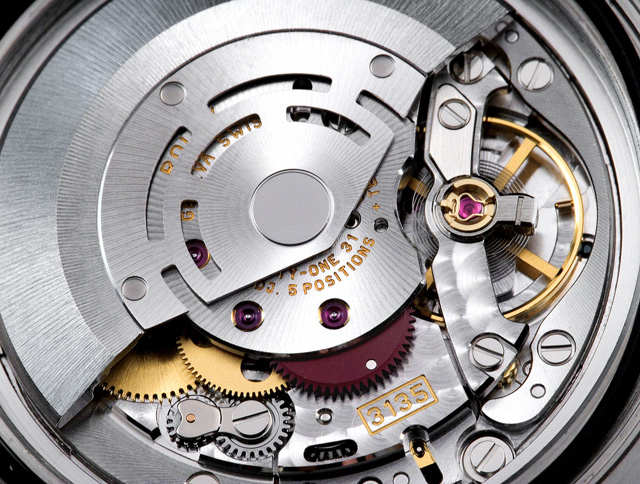
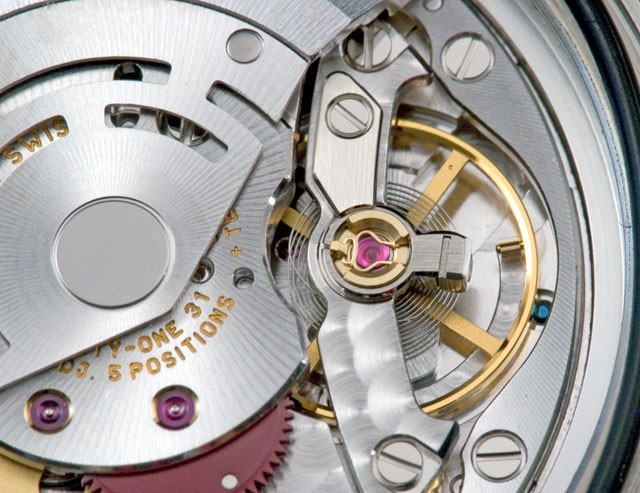
Sea-Dweller: Inside the Sea-Dweller beats the 31 jewel Rolex caliber 3135 (designed and manufactured entirely "in house" by Rolex) which has been in service since 1989. In those 18 years of service, the 3135 has garnered a reputation as being one of the most reliable, and robust watch movements ever created. At the same time, the movement has been criticized at times for lacking refinement and technological sophistication. True, the 3135 won't win any beauty contests (Rolex finishes and decorates a movement to a lesser degree than other manufacturers), but intentionally so. It was designed from the beginning as a movement to be encased in a stainless steel Oyster case, and endure rigorous conditions and treacherous environments - it's a clear case of function over form. I would also argue that the 3135 isn't lacking in technological sophistication - within the watch industry, Rolex Research and Development is regarded as being second to none. Rolex has implemented several, truly notable features into the 3135, such as a Breguet overcoil balance-spring, Microstella adjustment screws, and Kif shock absorption. The high-beat movement oscillates at 28,800 beats per hour (BPH). In short, it's hard to criticize Rolex for setting the benchmark which other manufactures strive to attain.. RATING: 8.0
WINNER: Sea-Dweller. The Omega 2500, comes very close to achieving what the 3135 has, with the biggest improvement coming in the form of the freely sprung balance wheel which Omega has implemented. Rolex gets the nod for being an unmodified, in house movement, and the higher beat speed.
PRESTIGE
Seamaster: Omega is an extremely well known, well respected brand, both within and outside watch enthusiast circles. Omega estimates their own brand recognition to be 70% world wide (7 out of every 10 people have heard of Omega watches). Omega marketing works hard to maintain and increase this recognition, and to associate the brand with celebrities and activities which suggest success and achievement. The Planet Ocean is a very new model, so very few people have heard of it outside of watch circles. RATING: 7.
Sea-Dweller: Rolex may well be the prestige standard by which all other watch brands are measured. Rolex is unequaled in their marketing efforts. Even people who know virtually nothing about watches recognize the Rolex name and associate with it being "the best." The prestige of the Sea-Dweller may well be gauged by who you're talking to - The SD has a cult following among both divers and watch enthusiasts, but the model is less well known among the general population . RATING: 9
Winner: Rolex is the hands down winner of this category. In fact, many people buy Rolex watches on this basis alone.
PRICE
Seamaster: $3400.00 retail is certainly a lot of money, but the "street" price of this watch can typically see a 30-35% discount off the retail price. The Planet Ocean is about $1000.00 or so more than the Seamaster Professional - that's pretty hard to justify, even with the Co-Axial caliber 2500. Since the current Planet Ocean version of the Seamaster has been around less than 3 yrs., long term pricing trends are inconclusive. Well maintained, vintage Omega Seamaster models hold and in some cases appreciate in value. Well maintained current model Seamasters seem to be holding roughly 50% of their retail value at this point. So, one can conclude that if a current model Seamaster is purchased either used or new at street price levels, then one stands to loose very little, if any of the purchase price if the watch is later sold. RATING: 7.0
Sea-Dweller: Three factors contribute to the current retail pricing and future value of Rolex watches. The Rolex policy of continuously, and regularly increasing the retail price is why the Sea-Dweller is currently priced at $5375.00 retail. Rolex is tyrannical when it comes to discounting, so it's rare to see a Rolex discounted any more than 10%, if at all. Additionally, Rolex controls production to ensure supply does not exceed demand. Obviously the closer to actual retail price one pays for a Sea-Dweller, the longer one will have to hold on to the watch without experiencing a loss when reselling (the asking price of a used Rolex seems to increase in direct proportion to the escalating retail price). But, one does have a better than fair chance of recouping their investment or even making some money if they sell their Sea-Dweller in the future. There is no empirical reason for the high price of the Sea-Dweller, yet Rolex sells every watch they make so they have no reason to alter their pricing policy. RATING: 6
Winner: The Planet Ocean isn't the bargain that the Seamaster Professional is (was - rumor has it that the SMP is being discontinued by Omega) but its still a fairly good value, and considerably less than the Sea-Dweller.
RESULTS
TOTAL POINTS POSSIBLE: 90
SEAMASTER PLANET OCEAN TOTAL POINTS: 74.5
SEA-DWELLER TOTAL POINTS: 76.5
TOTAL NUMBER OF CATEGORIES: 9
TOTAL CATEGORIES TIED: 0
TOTAL CATEGORIES SEAMASTER: 4
TOTAL CATEGORIES SEA-DWELLER: 5
Given that I purchased the Sea-Dweller and not the Planet Ocean, I recognize a degree of inherit bias on my part in evaluating these two watches. Still, only two points separate these two great watches.
From a less objective, and more personal standpoint - there's considerably more than two points between these two watches - the Planet Ocean just isn't for me, and I much prefer the Seamaster Professional from Omega. For me, the PO is just too darn big in the 45.5mm size, I don't like the flat black dial, I don't care for the hands, and the double AR coated crystal is an absolute deal breaker for me. I loved the polished accents on the Seamaster Professional bracelet, and I loved the distinctive shape of the scalloped bezel. In my mind, the Sea-Dweller is an absolute timeless classic, more aesthetically pleasing, and a much stronger diving tool than the Planet Ocean. The Planet Ocean seems more "trendy" to me - what happens in 10 years when Orange is no longer the color de jour, and oversized watches are out of favor? For me, there truly is only one King of the sea - the Sea-Dweller.
